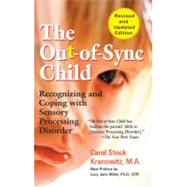
Note: Supplemental materials are not guaranteed with Rental or Used book purchases.
Purchase Benefits
Looking to rent a book? Rent Out-of-Sync Child : Recognizing and Coping with Sensory Integration Dysfunction [ISBN: 9780399531651] for the semester, quarter, and short term or search our site for other textbooks by Kranowitz, Carol; Miller, Lucy Jane. Renting a textbook can save you up to 90% from the cost of buying.
| Preface by Lucy Jane Miller, PhD, OTR | ix | ||||
| Foreword by Larry B. Silver, MD | xiii | ||||
| Acknowledgments | xix | ||||
| Introduction | xxi | ||||
| How to Use This Book | xxvii | ||||
| PART I: RECOGNIZING SENSORY PROCESSING DISORDER | 1 | (190) | |||
|
3 | (48) | |||
|
4 | (5) | |||
|
9 | (4) | |||
|
13 | (8) | |||
|
21 | (1) | |||
|
21 | (16) | |||
|
37 | (1) | |||
|
38 | (2) | |||
|
40 | (1) | |||
|
40 | (7) | |||
|
47 | (4) | |||
|
51 | (29) | |||
|
51 | (4) | |||
|
55 | (11) | |||
|
66 | (2) | |||
|
68 | (9) | |||
|
77 | (2) | |||
|
79 | (1) | |||
|
80 | (30) | |||
|
80 | (2) | |||
|
82 | (2) | |||
|
84 | (7) | |||
|
91 | (10) | |||
|
101 | (9) | |||
|
110 | (24) | |||
|
110 | (3) | |||
|
113 | (3) | |||
|
116 | (6) | |||
|
122 | (7) | |||
|
129 | (5) | |||
|
134 | (18) | |||
|
134 | (2) | |||
|
136 | (3) | |||
|
139 | (5) | |||
|
144 | (4) | |||
|
148 | (4) | |||
|
152 | (22) | |||
|
152 | (3) | |||
|
155 | (7) | |||
|
162 | (7) | |||
|
169 | (5) | |||
|
174 | (17) | |||
|
174 | (2) | |||
|
176 | (4) | |||
|
180 | (6) | |||
|
186 | (5) | |||
| PART II: COPING WITH SENSORY I'IZOCESSING DISORDER | 191 | (92) | |||
|
193 | (34) | |||
|
193 | (2) | |||
|
195 | (3) | |||
|
198 | (14) | |||
|
212 | (7) | |||
|
219 | (6) | |||
|
225 | (1) | |||
|
226 | (1) | |||
|
227 | (17) | |||
|
227 | (1) | |||
|
228 | (3) | |||
|
231 | (13) | |||
|
244 | (17) | |||
|
244 | (1) | |||
|
245 | (2) | |||
|
247 | (2) | |||
|
249 | (2) | |||
|
251 | (10) | |||
|
261 | (12) | |||
|
261 | (2) | |||
|
263 | (4) | |||
|
267 | (6) | |||
|
273 | (10) | |||
|
273 | (1) | |||
|
274 | (5) | |||
|
279 | (4) | |||
| Appendix A: The Sensory Processing Machine | 283 | (16) | |||
| Appendix B: Dr. Ayres's Four Levels of Sensory Integration | 299 | (6) | |||
| Glossary | 305 | (18) | |||
| Resources | 323 | (8) | |||
| About the Author | 331 | (2) | |||
| Selected Bibliography | 333 | (14) | |||
| Index | 347 |
The New copy of this book will include any supplemental materials advertised. Please check the title of the book to determine if it should include any access cards, study guides, lab manuals, CDs, etc.
The Used, Rental and eBook copies of this book are not guaranteed to include any supplemental materials. Typically, only the book itself is included. This is true even if the title states it includes any access cards, study guides, lab manuals, CDs, etc.